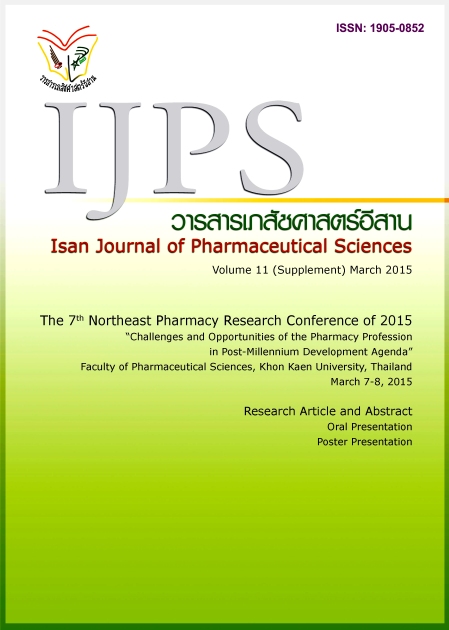Formulation of Cationic Niosomes for Gene Delivery: Effect of Molar Ratio of Cationic Lipid and Weight Ratio of Niosome/DNA Complexes
Main Article Content
Abstract
Introduction: Niosomes, non-ionic surfactant vesicles, have been widely used in pharmaceutical field as a drug and biological delivery system. The cationic lipids can generate positive charge on the surface of niosomes that make niosomes suitable for gene delivery. However, usage cationic lipid in high concentration may cause of toxicity and low transfection efficiency. The aim of this study was to investigate the effect of the molar ratio of spermine derivative-cationic lipid (Ay) in the cationic niosome formulations and the weight ratio of cationic niosomes/DNA complex on the transfection efficiency and the cytotoxicity in human cervical carcinoma cells (HeLa cells) using pDNA encoding green fluorescent protein (pEGFP-C2). Materials and Method: Various formulations of cationic niosomes were prepared from Tween 61, cholesterol and cationic lipid (Ay) at the molar ratio of 2.5:2.5:1, 2.5:2.5:1.5 and 2.5:2.5:2 using thin film hydration with sonication method. The measurements of size and zeta potential as well as gel retardation assay were performed in order to characterize the suitable weight ratio of cationic niosome/DNA complexes. Results: the transfection efficiency of these cationic niosomes was in the following order: niosomes (2.5:2.5:1) > niosomes (2.5:2.5:1.5) > niosomes (2.5:2.5:2). The highest transfection efficiency was observed in the formulation of niosomes at the molar ratio of (2.5:2.5:1) and the weight ratio of 10, moreover this formulation was safe in vitro. Conclusion: The molar ratios of cationic lipid in the cationic niosome formulations and weight ratios of cationic niosomes/DNA complexes are the important factor for transfection efficiency and cytotoxicity.
Article Details
In the case that some parts are used by others The author must Confirm that obtaining permission to use some of the original authors. And must attach evidence That the permission has been included
References
Lv H, Zhang S, Wang B, Cui S, Yan J. Toxicity of cationic lipids and cationic polymers in gene delivery. J Control Release, 2006, 114: 100-109.
Marianecci C, Di Marzio L, Rinaldi F, et al. Niosomes from 80s to present: the state of the art. Adv Colloid Interfac Sci, 2014, 205: 187-206.
Misra S. Human gene therapy: a brief overview of the genetic revolution. J Assoc Physicians India, 2013, 61: 127-133.
Pardakhty A, Moazeni E. Nano-niosomes in drug, vaccine and gene delivery; a rapid overview. Nanomedicine J. 2013, 1: 1-12.
Tros de Ilarduya C, Sun Y, Düzgüneş N. Gene delivery by lipoplexes and polyplexes. Eur J Pharm Sci, 2010, 40: 159-171.
Wasungu L, Hoekstra D. Cationic lipids, lipoplexes and intracellular delivery of genes. J Control Release, 2006, 116: 255-264.
Zhdanov RI, Podobed OV, Vlassov VV. Cationic lipid-DNA complexes-lipoplexes-for gene transfer and therapy. Bioelectrochemistry, 2002, 58: 53-64.


